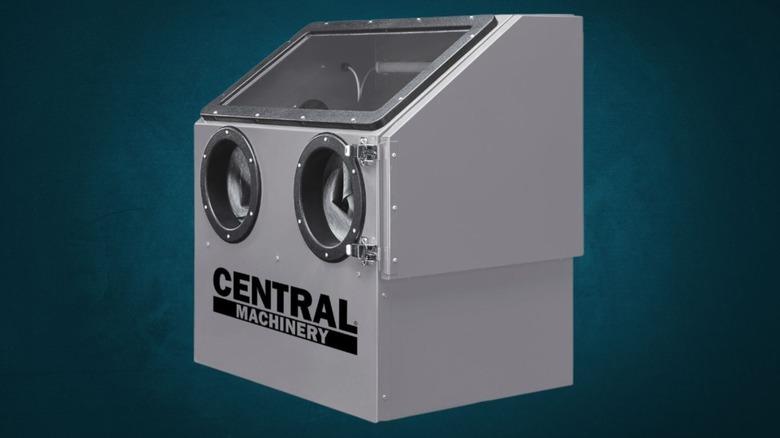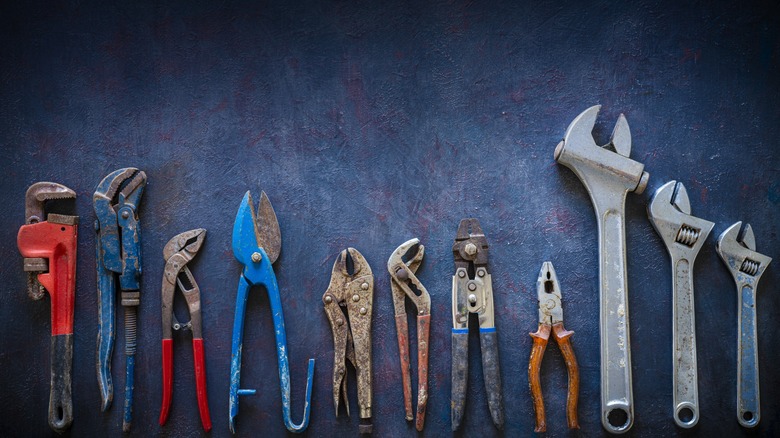Everything To Know About This Parts & Tools Blast Cabinet From Harbor Freight
If you hold onto a tool or that plastic container full of nuts and bolts for long enough, they're likely to get rusty or, if used often, caked with grime. The logical thing to do is to clean them, but some things don't come off easily with just soap and water. That leaves the alternative—a more abrasive cleaning solution that can really cut through the dirt and mess to make your tools and parts shine once more.
While you can try a harsher cleaning solution, Harbor Freight sells an alternative option that doesn't leave you in a fog of chemical fumes. Central Machinery's 30lb Benchtop Abrasive Blast Cabinet swaps out liquid cleaners for physical particles, which attack rust and other stubborn substances with a high-pressure blast.
The Central Machinery cabinet from Harbor Freight may look like something you'd find in a CDC lab, complete with built-in, durable gloves that protect your hands from the high-pressure abrasive media. Before you drop $200 on the 30-lb cabinet, there are a few things you should know beyond just price. Luckily, we have the lowdown.
How does the abrasive blast cabinet work?
Being only $200, you may consider Central Machinery's cabinet an entry-level model. Other options on the market could easily run closer to $300 to 500, like Eastwood's 25lb-capacity modular blaster. Despite the price difference, they share similar functions and can use the same media to blast automotive parts and tools clean.
The cabinet is only half the equation when it comes to cleaning. Its high-pressure system is designed with a siphon gun attached to an air hose that connects to an external source for clean compressed air.
The 30lb blaster from Central Machinery, a brand also known for its ultrasonic cleaners, supports a maximum operating air pressure of 100 pounds per square inch (PSI). This means the media chosen will shoot from the ceramic gun at a high velocity and chip or scrape away at the surface to remove foreign materials and rust.
Comparatively, Eastwood's costlier model has a lower air supply requirement of 7 cubic feet per minute (CFM) at 90 PSI compared to Central Machiner's 11CFM at 90 PSI. This would result in a slightly less impactful blast and more time needed to clean or smooth the same tool.
What media does the 30lb blast cabinet use?
You've likely noticed that we've used the word "media" several times when discussing how the cabinet cleans parts and tools. For blast cabinets, media is the material that's shot out of the gun to resurface the target object and the pound rating is how much of that media it can hold.
Harbor Freight sells different media that can be used with blast cabinets, including glass beads, black aluminum oxide, and baking soda. Other media options compatible with the blast cabinet include walnut shells and ground glass. Which you use depends on what you want to accomplish.
For your rusty parts or tools to look polished, you want harder media like aluminum oxide. A slightly softer medium like glass beads can remove some surface layer and leave a satin finish. Walnut shells may sound odd, but their low hardness level makes them a mildly aggressive agent that can strip materials from the surface without damaging the surface. Medium hardness also determines if it can be recycled and reused. For example, harder media like aluminum oxide can be reused more than once.
Though sand is also a possible blasting agent, the 30 lb blast cabinet from Harbor Freights warns against using it. According to the user manual, sand contains crystalline silica, which, per the National Cancer Institute, is considered a cancer-causing substance. With the many agents available, there should be no need to turn to sand.
What are users saying about the cabinet?
While there aren't any notable professional reviews for the 30-lb cabinet, there are a few user reviews to base a shopping decision on. The Smackey's Garage YouTube channel immediately ran into an issue that others may have if they don't consider the needs of the unit, and that's ensuring you have a strong enough air compressor. That may mean adding a larger compressor to your space, offsetting the cabinet's more compact tabletop size.
Barring some minor modifications, such as replacing the included hard-line hose with something more flexible, Smackey's Garage was largely positive about his time with the cabinet. This does align with many of the user reviews on Harbor Freight, where the cabinet boasts a 4.2-star review and is recommended by 92% of customers.
The cabinet's only one-star review (at the time of writing this) notes that it "leaks from rivets and edges." One of Smackey's Garage's points was that the unit was well-sealed and even came with extra silicone for upkeep if leaks were found.



